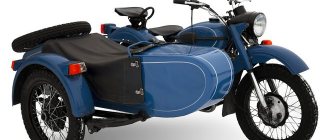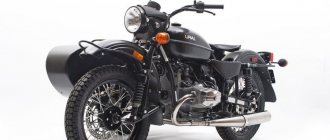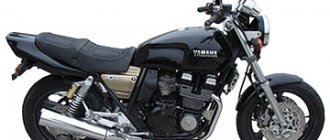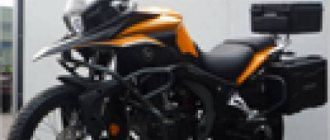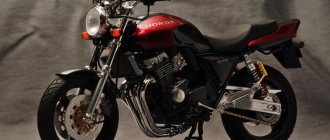Hello.
I came across an excellent article on motorcycle suspensions on the English-language Internet, I am posting its translation, since the information is presented simply, clearly and quite completely. The article is almost popular science, I don’t recommend it to hard-boiled theorists, but for those who want to understand the types of motorcycle suspensions without delving deeply into the details, it will be very useful. In fact, the most useful information for the average user has been collected.
Yes, and for owners of BMW motorcycles, this article will be of particular interest, since it has an entire paragraph devoted to the types of suspensions for motorcycles of this brand.
Background.
Suspension options for motorcycles are as varied as those for cars. Of course, the motorcycle only has two wheels, but this forces engineers to pay closer attention to the suspension. The most common type of motorcycle rear suspension is a swingarm with two shock absorbers or a swingarm with one shock absorber (monoshock). The most common front suspension option is a telescopic fork. Although, oddly enough, cruiser-style motorcycles that have no rear suspension at all are still common - the so-called “hardtail” (“dry frame” or “cracker”). In this case, the rear wheel axle passes through the frame. This is a kind of tribute to history, because until the 20s of the last century, the only thing that was between the road and the rider’s ass were the springs under the saddle and the tire pressure.
A few conclusions to help you make a choice
Only knowing all the advantages and disadvantages of gas-oil and oil shock absorbers can you make a choice based on your requirements for a motorcycle:
- Air ones are suitable for lovers of aggressive driving on flat roads - owners of “sports” racing on tracks;
- For bad roads and off-road conditions, it is better to choose an oil suspension, which will ensure comfortable movement;
- In any case, the new shock will be better than the old one, no matter what you purchase;
- A high-quality, expensive part will always be better than a cheap “Chinese” one.
In a nutshell about the geometry of the motorcycle.
Before you plunge into the murky world of technical terms outlined in this article, it would be useful to understand the basic logic of the suspension of any motorcycle. The following illustration shows the basic terms you will encounter.
Steering Axis - control axis; Rake Angle - “rake”, fork angle; Trail - “trail”, the distance on the ground between the wheel axis and a line extended from the axis of the steering column; Wheelbase - wheelbase, the distance between the axles of the front and rear wheels of a motorcycle.
Sportbikes have a small rake, which means the trail is also not great. A small trail gives less stability and stability, but it makes the motorcycle more easy to control and maneuverable. On the contrary, choppers, cruisers and customs have a large rake. More rake means more trail, which makes such motorcycles stable and stable in a straight line, but they are difficult to steer. Typically on motorcycles the rake fluctuates between 5 degrees. For example, the Yamaha R1 sportbike has a fork angle of 24 degrees, while the BMW K1200LT cruiser has a fork angle of 26.8 degrees.
Other signs of suspension problems
An attentive motorcyclist can notice problems with shock absorbers before they start to “punch”:
- There is a feeling of instability in driving the vehicle even on flat sections of the road;
- Unsteadiness appears in turns, it is difficult to maintain the planned trajectory;
- During operation of the suspension, third-party sounds appear - from creaking or squeaking to ringing and rumble;
- The shock absorber has leaked - traces of oil remain on it (this is especially dangerous, since fluid can get into the brakes, which can cause an accident).
There can be many reasons for such changes - most often it is the age of the motorcycle. Most of the equipment driving on our roads are heavily worn “Japanese”, whose oil seals are already cracked from time and atmospheric conditions, and the springs are simply worn out. The second type of devices is the “new Chinese”, in which in most cases the quality of materials leaves much to be desired from the very beginning. Motocross and enduro motorcycles also suffer greatly for obvious reasons.
Plunging when braking.
One of the drawbacks of telescopic forks is their tendency to compress when braking, causing the bike to nose-dive. Such bites depend most on the geometry of a particular motorcycle. When you brake, you slow the motorcycle forward. The force of inertia goes somewhere, and that “somewhere” is the front fork. Because the telescopic fork is at an angle to the vertical axis of the motorcycle and at an angle to the force vector pushing the motorcycle forward, some of that force compresses the suspension. Let's remember the school physics course. The force transmitted at an angle is equal to the main force multiplied by the cosine of the angle. Remember that the rake angle is calculated from the vertical axis? Therefore, the angle we are talking about is actually equal to the difference between 90° and the angle of the staff, that is, it is an additional angle to the staff. And since sine and cosine are mutually inverse functions, the cosine of the rake will be equal to the sine of the complementary angle. So for a rake of 25° degrees, we can use both the sine of the additional angle (65°) and the sine of the rake.
Look at the picture on the right and imagine that the rake of our motorcycle is 25°. Then the force that acts on the front fork of the motorcycle will be equal to the breaking force multiplied by the sine of the rake angle. For clarity, let's take a ridiculously small braking force of 1 Newton. Then our calculation will look like this: 1*sin(25)=0.4226 or 42.26%. That is, 42% of the braking force is distributed to the fork and puts pressure on the springs and oil. Now let's plug in the real numbers. Let's imagine that your weight is 100 kg, and the motorcycle weighs 165 kg. Braking force = mass*acceleration. By pressing the brake, you can easily achieve a deceleration of 1G, that is, 9 m/s?. In this case, the braking force is: 265 kg * 9 m/s? = 2385 newtons. If 42% of this force is applied to the springs and oil of the motorcycle, the fork has to cope with a force of about 1000 Newtons, which is equal to 100 kg. weight. It's like you're putting your entire body weight on the fork of the motorcycle - that's why we feel the dive.
The first shot in the war against dives was fired by the Honda concern, when in 1969 the engineers of this company developed the TRAC (Torque Reactive Anti-Dive Control) system, but it was used in the design of individual motorcycles until the 80s of the last century. In those days, the front fork hydraulics of a motorcycle interacted with the brake hydraulics and is best remembered for the Kawasaki GPZ900R, whose anti-dive system was called AVDS (Automatic Variable Damping System).
AVDS consisted of an additional hydraulic cylinder located at the bottom of each fork leg and connected to the calipers. The idea was to use the brake fluid pressure generated in the calipers to close the fork oil valve via a plunger, thereby increasing fork stiffness. A stiffer suspension reduced dive.
It sounded good, but many people disliked this system for one feature of the motorcycle’s behavior on bad roads. When braking on a rough road, riding a motorcycle was more like falling down a flight of stairs, since all the unevenness of the road was transmitted through the rigid fork to the motorcycle frame and, of course, to the rider. This also created an increased load on the motorcycle fork seals, which led to the need for their frequent replacement. Since then, these childhood diseases have been eliminated, and the developments of those years are often used in the design of forks of modern motorcycles.
TRAC.
Honda's TRAC system was somewhat different from Kawasaki's AVDS. According to Honda, hydraulic systems have two main disadvantages. Firstly, the additional hydraulic line gave the brakes a “wet” effect. Secondly, such systems are interdependent on each other. So Honda engineers decided that their system should be actuated by rotating the brake caliper itself. This made the system completely independent of the brake circuit. The brake calipers were not rigidly fixed to the feathers, but were located on movable brackets. When you press the brake, the friction force that arises between the brake pads and brake discs moves the calipers, the caliper presses on the anti-dive system valve installed directly in the motorcycle's seatstays. The Yamaha and Suzuki systems worked in approximately the same way, but the Honda system differed favorably from its competitors in that it worked tolerably on rough roads. The thing is that the TRAC system valve was floating and held in place by a spring. Thus, when hitting a bump, the oil had time to fill the space behind the valve, which actually turned off the system. Smart, right?
Steering dampers.
As already mentioned, with small fork rake values, the motorcycle steers easily and quickly, but suffers from a lack of stability at low speeds. This isn't much of an issue on sportbikes, which require precise handling while still being quite fast. The problems start when you hit a big enough bump. The motorcycle fork compresses, the wheelbase decreases, the motorcycle loses stability, and the front wheel dances from side to side. And so on until the fork unclenches and the wheelbase returns to its original length.
Once this happens, the gyroscopic effect that occurs on the front wheel causes the motorcycle to "bob its head." The gyroscopic effect causes the motorcycle's front wheel to wobble from side to side. In some cases, the handlebars dangle so much that the grips touch the motorcycle’s gas tank. Usually this all ends in a highside, when the motorcycle throws the rider forward, over itself.
At one time, this behavior of the motorcycle was the reason for the recall of a batch of Suzuki TL 1000S after a couple of weeks after they hit the windows of motorcycle dealerships. And this is the same reason that led engineers to develop steering dampers for motorcycles. A steering damper is a great thing to use on the track and if you don't fully trust your motorcycle. There are two main types of steering dampers: linear and rotary. Linear dampers consist of a hydraulic cylinder and a rod with a piston, one side is attached to the motorcycle handlebar, the other is attached to the frame. Such dampers are similar in appearance to shock absorbers and are not activated during normal driving, but as soon as the shock begins, the damper takes on most of the load.
Rotor steering dampers are also available. They are mounted on the motorcycle steering column above the bearing and work by increasing the steering column's resistance to sudden left-right movements. The resistance is achieved by damper hydraulics. Just try hitting one of the handlebars with your fist when the steering damper is installed - and you will understand how it works.
 YaP didn’t bother with the cable at all - he would have taken any suitable length with similar tips and free play the same or less.
YaP didn’t bother with the cable at all - he would have taken any suitable length with similar tips and free play the same or less. There the cap of the shell is removed (more precisely, it is pulled off. I don’t care which side), the plastic shell is cut with a knife to the required length and removed. Then, with the help of pliers and wire cutters, the inner (steel) spiral is bitten off and the cap is put back in place. We have a “new” cable of the required length. All sorts of tensioners can also be adjusted using a regular hacksaw (“cut lengthwise”) By the way, I made a speedometer cable in exactly the same way (from some “Chinese moped” that happened to be in the store at that time with similar “ends” “- I bought the bike with a broken cable) and drove with it for a year until I ordered a “native” one, which turned out to be even worse than the “collective farm”.
There the cap of the shell is removed (more precisely, it is pulled off. I don’t care which side), the plastic shell is cut with a knife to the required length and removed. Then, with the help of pliers and wire cutters, the inner (steel) spiral is bitten off and the cap is put back in place. We have a “new” cable of the required length. All sorts of tensioners can also be adjusted using a regular hacksaw (“cut lengthwise”) By the way, I made a speedometer cable in exactly the same way (from some “Chinese moped” that happened to be in the store at that time with similar “ends” “- I bought the bike with a broken cable) and drove with it for a year until I ordered a “native” one, which turned out to be even worse than the “collective farm”. PS. I also know how to solder cables and spare tires; all of them are soldered from just about anything.
PS. I also know how to solder cables and spare tires; all of them are soldered from just about anything. And the clutch is now “self-made”. And it goes no worse than the “original” ones for abnormal money (yes, yes, my cables are “only from Japan”. Without options, it’s too old a waste). The only thing I'm redoing is the bosses. I make them from bronze (from old Soviet taps) or brass (bolt + file) - they are soldered much better than any of the “universal kits”. The main thing is to drill it correctly for the cable. Moreover, my “original” casings are “simple”, and I select new ones with a nylon liner inside and as a result, the cable in the casing moves easier than the “original” one. And I only go to the store for “brakes”, “oil” and “tires”. For everything else, there are hands, the Internet, an ABC book and various types of “showdowns” (like the same ebay). It turns out much cheaper. Sometimes it’s funny: an aunt on eBay sold a “hardware set” (that’s what it was written, as I understand it, “inheritance from an ex”). As a result, I received a slightly worn box, a new piston (without rings), a balancer shaft, an unlimited number of liners, bushings, bearings and seals (new ones, of course), RR, stator genes - for 10 euros. Shipping started at 16:00 I just saw it and took it, even though it wasn’t necessary at all at that time.
And the clutch is now “self-made”. And it goes no worse than the “original” ones for abnormal money (yes, yes, my cables are “only from Japan”. Without options, it’s too old a waste). The only thing I'm redoing is the bosses. I make them from bronze (from old Soviet taps) or brass (bolt + file) - they are soldered much better than any of the “universal kits”. The main thing is to drill it correctly for the cable. Moreover, my “original” casings are “simple”, and I select new ones with a nylon liner inside and as a result, the cable in the casing moves easier than the “original” one. And I only go to the store for “brakes”, “oil” and “tires”. For everything else, there are hands, the Internet, an ABC book and various types of “showdowns” (like the same ebay). It turns out much cheaper. Sometimes it’s funny: an aunt on eBay sold a “hardware set” (that’s what it was written, as I understand it, “inheritance from an ex”). As a result, I received a slightly worn box, a new piston (without rings), a balancer shaft, an unlimited number of liners, bushings, bearings and seals (new ones, of course), RR, stator genes - for 10 euros. Shipping started at 16:00 I just saw it and took it, even though it wasn’t necessary at all at that time. But something has already come in handy. The rest is lying on the balcony - he doesn’t ask to eat. And such “cases” happen there a couple of times a year - consistently. The main thing is to have time to react. - And as for the rest... The person asks how to choose... It means “off topic” that there are different(!) options. Do you want to cook? Vari (although not everything is so simple there either - overheating is not acceptable, even “local”). Do you want to install something similar? Place it. Which one is easier?
But something has already come in handy. The rest is lying on the balcony - he doesn’t ask to eat. And such “cases” happen there a couple of times a year - consistently. The main thing is to have time to react. - And as for the rest... The person asks how to choose... It means “off topic” that there are different(!) options. Do you want to cook? Vari (although not everything is so simple there either - overheating is not acceptable, even “local”). Do you want to install something similar? Place it. Which one is easier?
The motorcycle suspension is front fork.
Structurally, telescopic forks of modern motorcycles are an evolution of the lever fork - the so-called “Girder” fork. Girder was one of the first attempts to improve motorcycle fork control, but it had one serious drawback: when hitting a bump, the motorcycle's wheelbase decreased, which led to a loss of stability. This drawback haunts various designs of motorcycle front suspensions even now, so you have a chance to catch a wobble even on a modern motorcycle. An article on the front suspensions will appear soon, but for now let’s move on to the rear ones.
Motorcycle rear suspension.
Two shock absorbers, a regular pendulum.
A motorcycle suspension option that has become a classic. An H-shaped swingarm attached at one end to the motorcycle frame; shock absorbers with springs are attached directly to the swingarm. That's all you could hope for when purchasing almost any motorcycle over the years of its evolution. This type of suspension began to be pushed aside by other types only in the 80s, when high-strength materials became available, which made it possible to switch to a different rear suspension geometry. But this slightly outdated design is still found on many modern motorcycles. The downside of this suspension is its flexibility during extreme driving. This drawback can only be eliminated by increasing the rigidity of the entire structure, therefore, increasing the unsprung mass, which interferes with the full operation of the suspension.
Monoshock absorber, old design, regular swingarm.
The first monoshock suspension system appeared on racing motorcycles in 1977. In fact, as experiments, this type of suspension has appeared and disappeared since the 1930s, but only went into mass production in the early 1980s.
The authorship of the term “monoshock absorber” itself belongs to Yamaha (Honda, for example, used the term “Pro Link”). The main advantage was the ability to reduce the weight of the motorcycle by restructuring the geometry of the rear suspension of the motorcycle and eliminating one of the shock absorbers. The shock absorber itself was still attached directly to the pendulum, but was located in the center, almost horizontally.
Monoshock absorber, new design, regular swingarm.
The new design of the rear suspension provided for mounting the monoshock absorber not directly to the pendulum, but through a system of connections.
Progression was added to the design, and the shock absorber itself began to be positioned more vertically, which had a positive effect on its functions, and the “cage” of a complex design was replaced with a conventional H-shaped pendulum. To develop this design, engineers only needed a little more welding and stronger material.
Monoshock absorber, pendulum with cantilever mounting of the rear wheel.
The pinnacle of evolution of motorcycle rear suspensions today is a monoshock absorber with a cantilever swingarm. This is a super light and super rigid design, which is used, for example, on the Honda VFR800.
The main advantage of this design is the ability to quickly replace the rear wheel of a motorcycle. This benefit isn't as noticeable if you only ride your bike on the weekends, but Moto-GP racing team mechanics appreciate the time savings this procedure provides. The cantilever pendulum must be made of high-strength materials and have a proven design, since the entire load falls on one single arm. If classical pendulums must mainly withstand bending loads, then a cantilever pendulum must also withstand torsional loads. That is why pendulums of this design are quite massive in shape and have several stiffening ribs.
One shock absorber or two? Foaming of oil in shock absorbers.
In the good old days, all motorcycles had two rear shock absorbers. In the course of evolution, the design of two shock absorbers was replaced by a monoshock absorber. Question: why?
And the answer is quite simple. In a system of two shock absorbers, they are located quite close to the rear wheel. This means that the piston inside the shock absorber moves almost the same distance that the pendulum travels. Large bumps force the piston to travel a distance of 10 centimeters up and then down, which gives the effect of foaming the oil inside the shock absorbers. When the consistency of the oil begins to resemble a Frappuccino, the shock absorbers begin to handle bumps much worse.
A monoshock system involves mounting directly at the base of the swingarm. The pendulum moves up and down the same distance, but the shock absorber piston travels a much shorter distance than with a pair of shock absorbers. And modern progression systems further soften the load on the shock absorber. Thus, the monoshock absorber copes with large bumps more easily and handles small ones faster. Looking ahead, I would like to note that, reading the paragraph about BMW suspensions, you will understand why the shock absorber mount on the first Paralever was subsequently shifted to the very base of the pendulum - precisely because the original design with a mount at the rear wheel did not provide any advantages over the same suspension design with two shock absorbers.
Air or oil shock absorber?
Before choosing a suspension replacement device, you need to understand the terminology. There are no “air” shock absorbers - there are oil (hydraulic) and gas (gas-oil, pneumatic) shock absorbers. To understand which ones are better, it is important to understand their features.
The oil suspension has low compressibility in general, and therefore absorbs surface unevenness very well, featuring smooth operation. It has both its advantages and disadvantages.
Advantages of oil shock absorbers:
- Softer operation means a more comfortable ride;
- This option is easier to produce - and therefore much cheaper;
- The oil suspension can be repaired in case of leakage.
Disadvantages of this option:
- There is air inside the device, which can “leak” over time, causing the shock absorber to lose its properties;
- During operation, the oil heats up very much, becomes more liquid, causing the suspension to become loose and can “punch”;
- If you like to ride in cold weather, remember that at low temperatures, on the contrary, the oil will become more viscous - and the shock absorber, accordingly, will be very stiff.
Gas or, as they are popularly called, air shocks have in their design a compensation chamber with gas under high pressure. They also have their advantages and disadvantages.
Advantages of air shock absorbers:
- They work more rigidly, which increases the handling of the motorcycle, especially its control in corners and on wet roads;
- Changing temperatures from high to low and vice versa has virtually no effect on the shock-absorbing function - such devices work the same in any weather;
- More durable, service life is at least a third higher.
Disadvantages of this option:
- The cost is much higher than oil ones;
- Less riding comfort;
- On “our roads” they wear out quite quickly.
